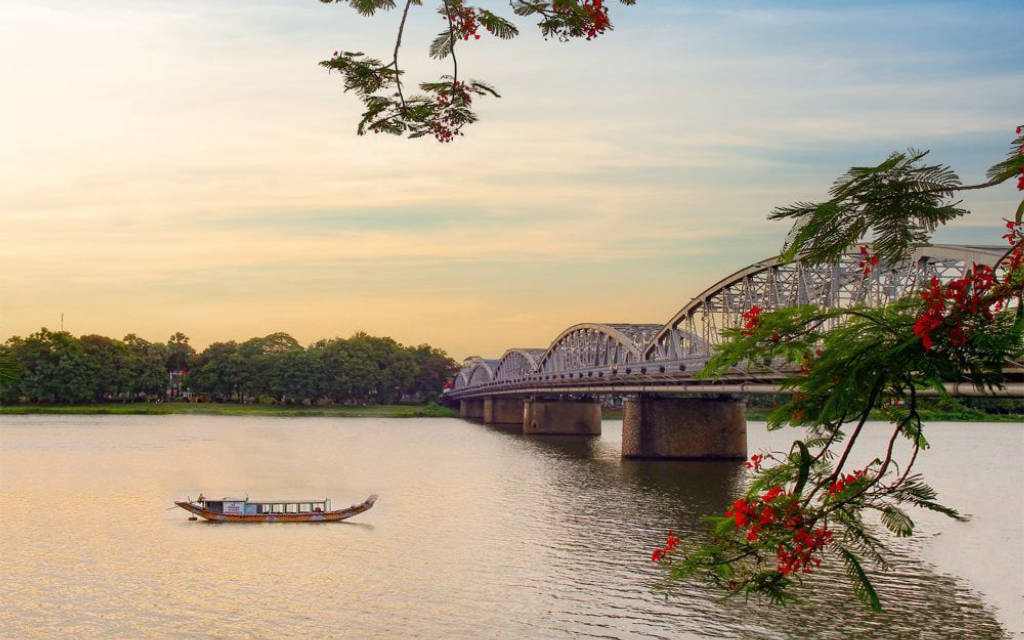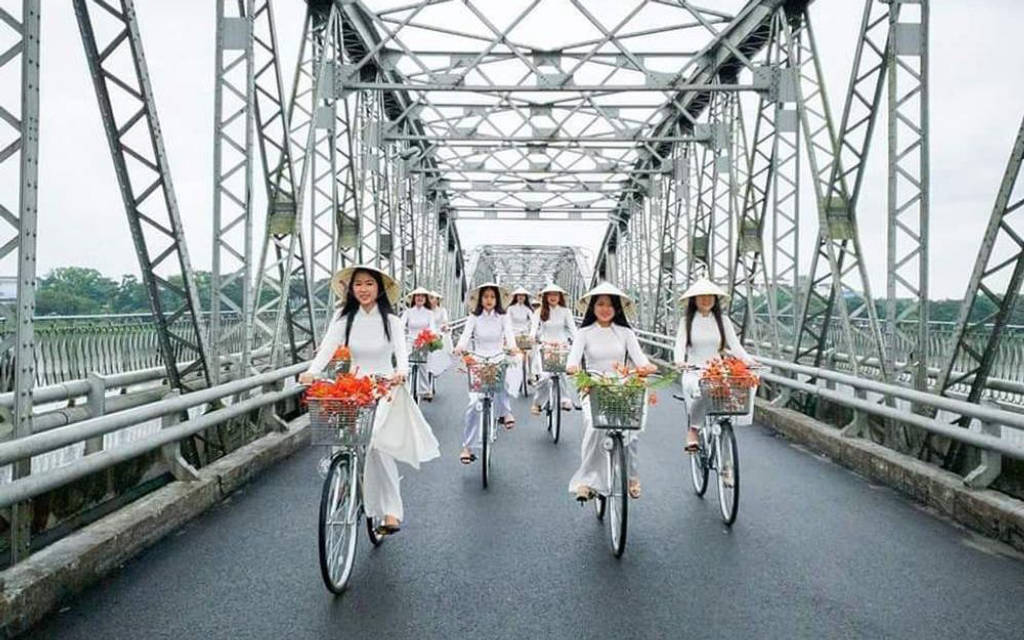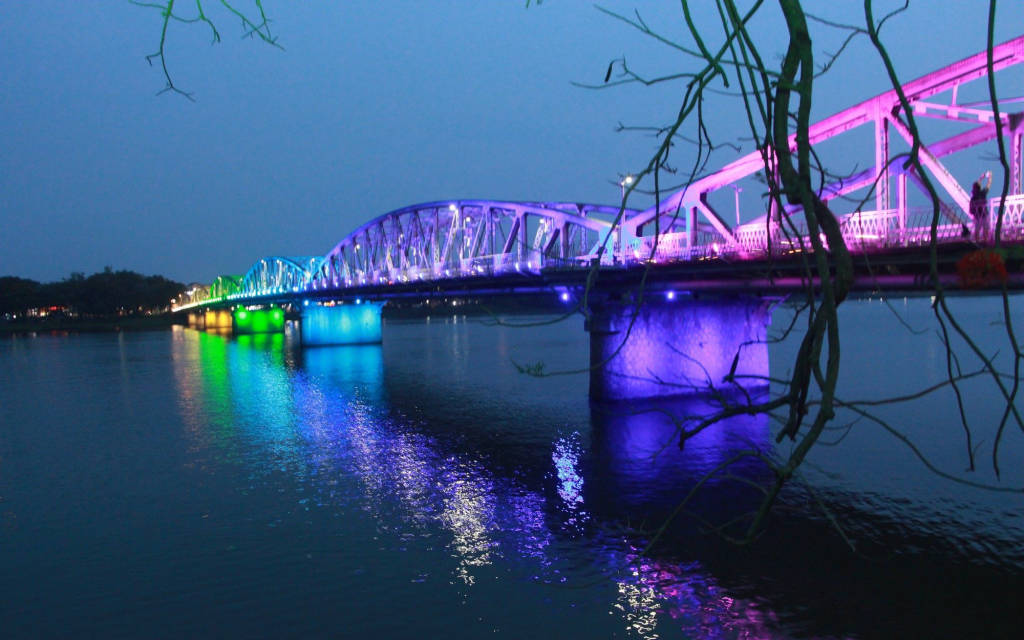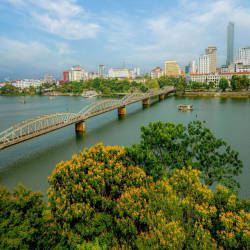Truong Tien Bridge or Trang Tien, a historic bridge spanning the Huong River, is a cultural symbol of Hue. Built in 1899 under the reign of King Thanh Thai, the bridge features a unique Gothic architecture with six soft steel girders. Not only is it an attractive tourist destination, it also preserves historical and cultural values and is an endless source of inspiration for poetry and art.
Truong Tien Bridge – The Graceful Symbol of Dreamy Hue
Truong Tien Bridge, an eternal symbol of Hue, has existed for over a century, connecting the two banks of the gentle Huong River and becoming an indispensable icon of the ancient capital.
1. Location and Importance
Truong Tien Bridge, also known as Trang Tien Bridge, spans the Huong River, connecting Phu Hoi Ward and Phu Hoa Ward in the center of Hue City. This is not only an important transportation work but also carries special historical, cultural, and artistic value. With a length of 402.6 meters and six steel spans, the bridge resembles a silver comb brushing the green hair of the Huong River, highlighting the tranquil and ancient beauty of the capital.
2. Construction History
Truong Tien Bridge first appeared during the reign of King Le Thanh Tong with the initial bridge made of rattan, hence also known as May Bridge or Mong Bridge. Over time, the bridge was rebuilt with wood, and its deck was paved with ironwood planks.
King Thanh Thai had the bridge constructed in 1899, designed by the firm Schneider et Cie et Letellier, and inaugurated in 1900. The bridge, named Cau Thanh Thai, was entirely made of steel with Western architecture. The bridge was 400 meters long, 4.5 meters wide, with six spans, each 66.66 meters long, and the construction cost amounted to 732,456 Francs.
In 1904, a major flood swept away four spans of the bridge. Subsequently, the company Daydé et Pillé (also the designer of Long Bien Bridge) repaired and rebuilt the four spans. In 1907, when King Thanh Thai was exiled to Réunion Island by the French colonists, the bridge was renamed Clémenceau Bridge after Georges Clemenceau, a French Prime Minister during World War I.
With the rapid development of transportation, Truong Tien Bridge became degraded. In 1937, under the direction of engineer Martin André, the Eiffel company (founded by Gustave Eiffel – who also designed the famous Eiffel Tower in Paris) carried out renovations, upgraded the bridge, replaced the steel beams, broadened the sidewalk and sidewalks for pedestrians . After 29 months of construction, the project was completed in 1939.
Throughout history, Truong Tien Bridge underwent many repairs and reconstructions, especially during wars. In 1945, the bridge was renamed Nguyen Hoang Bridge, and after the Tet Offensive in 1968, the bridge was partially destroyed. Despite that, the bridge was temporarily repaired and continued to be an important part of Hue's transportation and culture. Truong Tien Bridge underwent major restoration in 1991, including changing the paint color and narrowing the bridge's width. Since Hue Festival 2002, the bridge has been equipped with a modern color-changing lighting system.
3. Unique Architecture
Truong Tien Bridge is designed in Gothic style with six comb-shaped steel spans, creating a graceful and soft appearance, resembling a ribbon spanning the river. When viewed from afar, the bridge looks like a harmonious painting between nature and architecture, blending with the beauty of the Huong River and Hue's sky. In the evening, the modern LED lighting system transforms the bridge into a shimmering "rainbow strip" with continuously changing colors, attracting many tourists and locals to admire.
4. Tradition and Culture
Truong Tien Bridge is not just a transportation structure but also carries the cultural breath of Hue. It has been closely associated with the lives of Hue's people through generations. During major festivals such as Hue Festival, the bridge often becomes the centerpiece of artistic programs, a place for light and music performances, bringing unforgettable experiences to visitors.
Additionally, the bridge has entered poetry and music. Anyone who has heard the folk verse:
"The Truong Tien Bridge, with six pairs and twelve spans,
I couldn't keep up with you,
It's my fault, my love.
For so long, I've been bearing your words,
Even if you leave me,
It's because of fate."
will feel the deep love that people have for this bridge.
5. Truong Tien Bridge in the Hearts of Hue's People
For Hue's people, Truong Tien Bridge is not just a bridge but a symbol of national pride. It is a place that preserves memories, a meeting point for generations. The bridge is like a silent witness, observing Hue's changes through different periods and historical ups and downs.
6. Conclusion
Ladies and gentlemen, Truong Tien Bridge is not just a bridge connecting the two banks of the Huong River but a place that connects the past and present, connects people with nature, and connects hearts that love dreamy Hue. Once you visit here, you will understand why people always mention Hue with deep affection. Let this journey be etched in your heart just like the resilient Truong Tien Bridge through time.
Wonderful Experiences When Visiting the Bridge
• Watching the Sunset: As the sun sets, standing on Truong Tien Bridge, you can admire the sparkling golden Huong River, a breathtaking scene like no other.
• Walking on the Bridge: Strolling on the bridge, feeling the cool breeze from the Huong River, listening to the gentle waves against the bridge, all worries seem to fade away.
• Taking Photos: With its poetic beauty, Truong Tien Bridge is an ideal location to capture memorable photos during your Hue exploration.
• Enjoying Local Cuisine: Under the bridge, street vendors sell various Hue specialties such as sweet soup, banh beo, banh loc... An experience you should not miss.
 Register
RegisterSign in Travel Agent
Sign in Supplier
Sign in Affiliate
Sign in Guru









 P. Phú Hòa, Tp. Huế, T. Thừa Thiên Huế, Việt Nam
P. Phú Hòa, Tp. Huế, T. Thừa Thiên Huế, Việt Nam